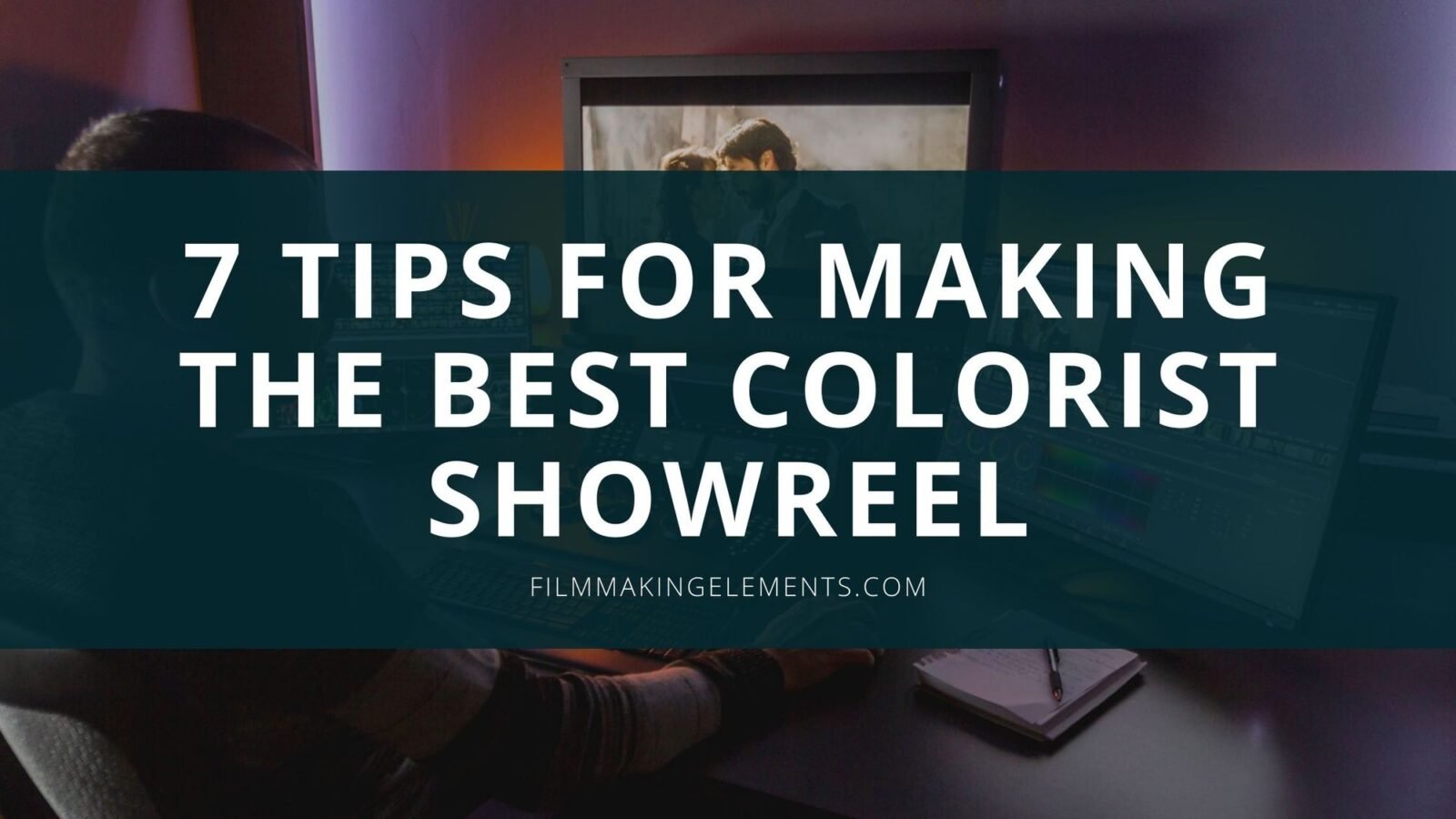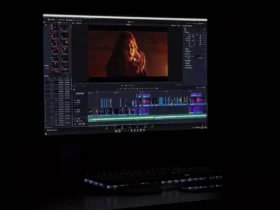Hi, I’m Salik, the author of FilmmakingElements.com. I have been a filmmaker for over 10 years. I am also a certified DaVinci Resolve Trainer and I have used DaVinci Resolve for many of my projects. In this article, I share some valuable Tips For Making A Colorist Showreel so that you can land up your dream projects.
The process of creating a color grading showreel is challenging. When creating your first showreel, you might not have had a lot of options for footage to include, but as you progress as a colorist, you’ll find that putting together a successful showreel requires a lot of thought.
You must be able to condense all of your hours of grading, polishing your creativity and technical understanding, into a compilation film that will eventually assist a business in deciding whether or not to grade with you.
When it arrives to directors or ad firm professionals seeing your showreel, the technical element of color grading is tossed out the window, and your client cares nothing about it. People think that if you declare yourself a professional colorist, you know all there is to know about all workflows and camera formats. They judge you only on your originality and prior work.

Professional colorists and artists spend weeks considering the atmosphere and central group the showreel will target.
They work on the pace and rhythm of the showreel according to the region they want to target, the culture they want to target, the industry they want to target, and many more criteria.
So I thought it would be fascinating to share some of the ideas and questions we ask before creating a new reel.
7 Tips For Making The Best Colorist Showreel
1. The Magic Of Pacing and Music

Creating a showreel is an art form in itself. While the contents of the reel showcase your skill as a colorist, the pacing and the choice of music convey the story of your creative journey and sensibilities.
Understanding the Role of Pacing and Music:
Pacing and music aren’t just about adding a backdrop to your work; they create the atmosphere and set the mood. The right pacing ensures that each shot gets its moment to shine, while the music adds an emotional layer that can resonate with the viewer.
Influence of Cultural and Personal Experiences:
A colorist’s aesthetic choices are inevitably shaped by their life experiences – the environment they grew up in, their cultural background, the kind of music they listen to, the films they cherish, and so much more. These elements subtly influence the way they perceive and use color, and it can be intriguing to reflect this personal touch in the showreel.
Choosing the Right Music:
While your personal music preference is essential, the showreel should feature a track that complements and elevates the work you’re presenting. Just because you love a particular genre or band doesn’t mean it’s the right fit for your showreel. Although I enjoy a lot of hard rock music, I do not include Metallica in my showreel, of course. The imagery and shot-to-shot flow are the most critical aspects of the showreel, and if the music isn’t working, ditch it! Scrape the music if you think your reel is not capable of pulling off such a slow-paced cut and song.
Be Ready to Make Tough Choices:
The showreel should be a reflection of your best work, and sometimes this means making hard decisions. If the music isn’t elevating your reel or if the pacing feels off, be prepared to adjust. Whether it’s changing the track or re-editing to achieve better flow, always prioritize the overall impact of your reel.
Also Read- What Is A 3×3 Matrix In Color Grading- In Depth
Some Showreel Examples
2. Don’t be overconfident with your skills.
Crafting a showreel is as much about showcasing your work as it is about presenting yourself as a professional. While there’s no universally accepted blueprint for a colorist showreel, some key principles can guide you in maximizing its impact. One of these principles is to maintain humility and self-awareness throughout the process.
Balancing Confidence with Humility:
In the world of color grading, the goal is to enhance and elevate visuals to their utmost potential. It’s essential to apply the same diligence when curating your showreel. While believing in your abilities and strengths is crucial, remember to approach your work with a sense of humility.
Understanding Your Audience:
Your showreel will be viewed by industry professionals who have seen a plethora of reels throughout their careers. Overconfidence can be easily discerned, and it might lead to your reel being overlooked. Strike a balance in your presentation — showcase your best work without appearing as if you believe you’re the sole maestro in the field.
Seek Feedback:
One effective way to avoid the trap of overconfidence is to regularly seek feedback. Before finalizing your showreel, share it with mentors, peers, or industry professionals. Their insights can provide you with an external perspective, allowing you to refine and polish your reel further.
Stay Updated and Evolve:
The world of color grading is constantly evolving with new techniques, tools, and trends. Keeping yourself updated and being open to learning is a sign of humility and passion for the craft. Incorporating newer techniques and staying relevant can make your showreel stand out.
3. The marketing of names and faces is a lucrative business.
The realm of color grading is not only about displaying technical proficiency but also about building trust. In this industry, your credentials and associations play a significant role in marketing yourself. Here’s why and how you should leverage them in your showreel:
Highlight Notable Collaborations:
If you’ve had the privilege to work with renowned personalities, influential brands, or on high-profile projects, these should find a prominent spot in your reel. Such collaborations not only add a feather to your cap but also imply a level of trustworthiness and professionalism.
Understanding the Audience’s Perspective:
When crafting a showreel, keep in mind that it will be viewed by a varied audience. Producers and directors may have different priorities when evaluating your reel. For a director, the creative interpretation and finesse might be the focal points. In contrast, a producer might be more interested in reliability, timeliness, and trustworthiness.
Building Credibility:
Imagine a producer with a high-budget ad campaign featuring a globally recognized celebrity. Their primary concern is not just the quality of the grade but also the assurance that the project will be handled responsibly and delivered on schedule. When your reel showcases familiar faces and brands, it subtly conveys that you have been trusted with important projects before and have successfully delivered.
Balance is Key:
While it’s beneficial to highlight significant collaborations, ensure that your showreel doesn’t rely solely on them. A diverse portfolio showcasing a range of projects, from indie films to big brand commercials, can demonstrate your versatility and adaptability.
A producer, for example, has a $100k advertisement with a well-known celebrity supporting a watch that needs to be graded. Of course, they want it to appear great, but the most important thing to them is that it is graded and delivered on time. So when they see some well-known persons or items on your reel, they realize that you were entrusted with a high-profile project and that you successfully completed it.
Also Read- Is Davinci Resolve Free? Is It Good for Beginners ? in 2022
4. Your showreel should constantly be evolving.
Your showreel should be developing all the time. Try enforcing this rule with your ShowReel—once it’s complete, nothing new can be added without something old being removed. Please don’t make the Showreel longer as you obtain additional content; instead, make it stronger!
Yes, if you’re just getting started, it may take some time to accumulate enough high-quality footage for a two-minute clip. It took me 4 years to accumulate enough quality footage to fill a two-minute reel when I transitioned from editorial to purely color grading.
5. Choose your target market.

The first step is to determine who your showreel is intended for. It should be targeted at the type of company you want to lure. If you’re looking for feature film work, a fast-paced, cut-heavy music montage reel won’t appeal to them, and if you’re looking for music video work, a lot of drama work won’t.
Of course, you may have numerous reels, but I found it difficult enough to maintain and update several reels at once, so I opted to concentrate on just one specialty and have just one reel.
6. Should you use Before and After in your Colorist Showreel?
On showreels, before and after analyses are a trendy topic. There is no place on my reel for before, and after swipes, for the sort of grading, I’m after. The competition has been increasing every day in the filmmaking industry or any industry for that matter.
Also, the new age of media and entertainment has enticed people to engulf shorter-length content. So usually, professional colorists prevent using before and afters, rather concentrate on creating a flow that engages the viewer till the end.
The reason for this is that my clients don’t care how the image looked previously. It may appear harsh, but commercial directors and agencies have a choice of roughly 30 colorists and are in touch with several Line Producers to get one on board.
They know we’re all good since we wouldn’t be working at such enormous facilities or working with established brands if we weren’t, but they want to find out who’s the best.
It’s all up to you. Before and after work will make a tremendous impact for some types of customers, especially if they don’t know much about color correction and finishing; however, if you’re chasing high-quality commercial or theater work, I would advise you to delete all before and after work. Look at what other colorists in your position are doing and decide what works best for you.
7. What should be the length of my colorist showreel

I have talked about this enough in the other tips, but I want it to be repeated again. Your clients don’t have time. Keep this in your head when you are editing your showreel.
Keeping the showreel short in between 1-2 minutes is a major. After having a word with fellow producers, they stated that it’s a rare chance to see a showreel for more than even 30 seconds.
It would be best to make sure that the flow and the first impression are your best shot so that the viewer sticks to the end. Also, don’t try to include your best and favorite projects at the starting of the showreel but don’t make it weigh one side.
Also Read- Cut Tab Vs. Edit Tab of DaVinci Resolve: 8 Surprising Differences










